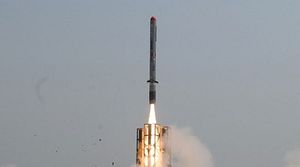India’s Defense Research and Development Organization (DRDO) is slated to conduct the final developmental flight trial of the nuclear-capable Nirbhay cruise missile, the country’s first indigenously designed and developed long-range cruise missile, according to an official of India’s Aeronautical Development Establishment (ADE).
Preparations are under way for a low-altitude flight test the ADE official told Jane’s during the February 20-24 Aero India 2019 exhibition in Bangalore. The last successful test launch of the missile took place at the Integrated Test Range on Abdul Kalam Island off the coast of Odisha in November 2017. A Previous test launch in December 2016 ended in failure as the missile had to be destroyed in mid-air after it deviated from its course.
Two other test launches also ended in failure, with only one other flight trial, conducted in October 2014, declared a success. DRDO engineers have pointed to problems with the flight control software and navigation system of the Nirbhay, as well as hardware design flaws, for the causes of the failed missile tests. Without offering any details, the ADE officials noted that past issues related to the missile’s control hardware and software have apparently now been fixed.
“The ADE official said that the missile program is on track and expressed optimism that the weapon will soon be moving into the production-standard configuration, followed by the operational testing phase,” Jane’s reports on February 21. “He added that once the technology behind the missile is certified, there is a proposal to develop an air-launched variant of the Nirbhay within two to three years.”
The Nirbhay is a subsonic long-range land attack cruise missile that can be armed with a 300-kilogram warhead. The nuclear-capable, solid fuel, missile is capable of reaching speeds of 0.6-0.7 Mach and can strike land targets at a distance of up to 1,000 kilometers. Notably, while the Nirbhay missiles for the first four trials were powered by Russian-made NPO Saturn 36MT mini turbofan engines, the missile prototype slated to be launched in April will carry the indigenously designed and developed Manik turbofan engine.
The Ministry of Defense (MoD) has considered axing the Nirbhay program on multiple occasions over the past years for numerous reasons including technical issues with the weapon system, funding difficulties, and questions over the operational need for a subsonic, long-range cruise missile given the existence of the more reliable but shorter ranged BrahMos supersonic cruise missile.
Notably, DRDO is working on an extended-range air-launched variant of the BrahMos supersonic cruise missile, designated BrahMos-ER, with an estimated strike range of around 800 kilometers. The development of a new 800-kilometer range BrahMoS-ER could be an indication that India will deploy the BrahMos as part of the air component of its nuclear triad, although the Indian government has not publicly confirmed to date that it is seeking a nuclear capability for the supersonic cruise missile.
































